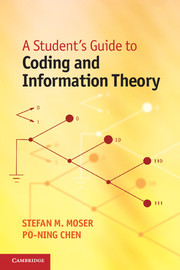References[BGT93] Claude, Berrou, Alain, Glavieux, and Punya, Thitimajshima, “Near Shannon limit error-correcting coding and decoding: turbo-codes,” in Proceedings of IEEE International Conference on Communications (ICC), Geneva, Switzerland, May 23–26, 1993, pp. 1064–1070.
[Bla88] Richard E., Blahut, Principles and Practice of Information Theory. Addison-Wesley, Reading, MA, 1988.
[Bry92] Victor, Bryant, Aspects of Combinatorics: A Wide-Ranging Introduction. Cambridge University Press, Cambridge, 1992.
[BT02] Dimitri P., Bertsekas and John N., Tsitsiklis, Introduction to Probability. Athena Scientific, Belmont, MA, 2002.
[CA05] Po-Ning, Chen and Fady, Alajaji, Lecture Notes on Information Theory, vol. 1, Department of Electrical Engineering, National Chiao Tung University, Hsinchu, Taiwan, and Department of Mathematics & Statistics, Queen's University, Kingston, Canada, August 2005. Available: http://shannon.cm.nctu.edu.tw/it/itvol12004.pdf
[CS99] John, Conway and Neil J. A., Sloane, Sphere Packings, Lattices and Groups, 3rd edn. Springer Verlag, New York, 1999.
[CT06] Thomas M., Cover and Joy A., Thomas, Elements of Information Theory, 2nd edn. John Wiley & Sons, Hoboken, NJ, 2006.
[DM98] Matthew C., Davey and David, MacKay, “Low-density parity check codes over GF(q),” IEEE Communications Letters, vol. 2, no. 6, pp. 165–167, June 1998.
[Fan49] Robert M., Fano, “The transmission of information,” Research Laboratory of Electronics, Massachusetts Institute of Technology (MIT), Technical Report No. 65, March 17, 1949.
[For66] G., David Forney Jr., Concatenated Codes. MIT Press, Cambridge, MA, 1966.
[Gal62] Robert G., Gallager, Low Density Parity Check Codes. MIT Press, Cambridge, MA, 1962.
[Gal68] Robert G., Gallager, Information Theory and Reliable Communication. John Wiley & Sons, New York, 1968.
[Gal01] Robert G., Gallager, “Claude E. Shannon: a retrospective on his life, work, and impact,” IEEE Transactions on Information Theory, vol. 47, no. 7, pp. 2681–2695, November 2001.
[Gol49] Marcel J. E., Golay, “Notes on digital coding,” Proceedings of the IRE, vol. 37, p. 657, June 1949.
[Gol82] Solomon W., Golomb, Shift Register Sequences, 2nd edn. Aegean Park Press, Laguna Hills, CA, 1982.
[Har28] Ralph, Hartley, “Transmission of information,” Bell System Technical Journal, vol. 7, no. 3, pp. 535–563, July 1928.
[HP98] W., Cary Huffman and Vera, Pless, eds., Handbook of Coding Theory. North-Holland, Amsterdam, 1998.
[HP03] W., Cary Huffman and Vera, Pless, eds., Fundamentals of Error-Correcting Codes. Cambridge University Press, Cambridge, 2003.
[HW99] Chris, Heegard and Stephen B., Wicker, Turbo Coding. Kluwer Academic Publishers, Dordrecht, 1999.
[Kar39] William, Karush, “Minima of functions of several variables with inequalities as side constraints,” Master's thesis, Department of Mathematics, University of Chicago, Chicago, IL, 1939.
[Khi56] Aleksandr Y., Khinchin, “On the fundamental theorems of information theory,” (in Russian), Uspekhi Matematicheskikh Nauk XI, vol. 1, pp. 17–75, 1956.
[Khi57] Aleksandr Y., Khinchin, Mathematical Foundations of Information Theory. Dover Publications, New York, 1957.
[KT51] Harold W., Kuhn and Albert W., Tucker, “Nonlinear programming,” in Proceedings of Second Berkeley Symposium on Mathematical Statistics and Probability, J., Neyman, ed. University of California Press, Berkeley, CA, 1951, pp. 481–492.
[LC04] Shu, Lin and Daniel J., Costello Jr., Error Control Coding, 2nd edn. Prentice Hall, Upper Saddle River, NJ, 2004.
[Mas96] James L., Massey, Applied Digital Information Theory I and II, Lecture notes, Signal and Information Processing Laboratory, ETH Zurich, 1995/1996. Available: http://www.isiweb.ee.ethz.ch/archive/massey_scr/
[McE78] Robert J., McEliece, “A public-key cryptosystem based on algebraic coding theory,” DSN Progress Report 42-44, Technical Report, January and February 1978.
[McE85] Robert J., McEliece, “The reliability of computer memories,” Scientific American, vol. 252, no. 1, pp. 68–73, 1985.
[McE87] Robert J., McEliece, Finite Field for Scientists and Engineers, Kluwer International Series in Engineering and Computer Science. Kluwer Academic Publishers, Norwell, MA, 1987.
[MS77] F., Jessy MacWilliams and Neil J. A., Sloane, The Theory of Error-Correcting Codes. North-Holland, Amsterdam, 1977.
[Nor89] Arthur L., Norberg, “An interview with Robert M. Fano,” Charles Babbage Institute, Center for the History of Information Processing, April 1989.
[Pin54] Mark S., Pinsker, “Mutual information between a pair of stationary Gaussian random processes,” (in Russian), Doklady Akademii Nauk SSSR, vol. 99, no. 2, pp. 213–216, 1954, also known as “The quantity of information about a Gaussian random stationary process, contained in a second process connected with it in a stationary manner.”
[Ple68] Vera, Pless, “On the uniqueness of the Golay codes,” Journal on Combination Theory, vol. 5, pp. 215–228, 1968.
[RG04] Mohammad, Rezaeian and Alex, Grant, “Computation of total capacity for discrete memoryless multiple-access channels,” IEEE Transactions on Information Theory, vol. 50, no. 11, pp. 2779–2784, November 2004.
[Say99] Jossy, Sayir, “On coding by probability transformation,” Ph.D. dissertation, ETH Zurich, 1999, Diss. ETH No. 13099. Available: http://e-collection.ethbib.ethz.ch/view/eth:23000
[Sha37] Claude E., Shannon, “A symbolic analysis of relay and switching circuits,” Master's thesis, Massachusetts Institute of Technology (MIT), August 1937.
[Sha48] Claude E., Shannon, “A mathematical theory of communication,” Bell System Technical Journal, vol. 27, pp. 379–423 and 623–656, July and October 1948. Available: http://moser.cm.nctu.edu.tw/nctu/doc/shannon1948.pdf
[Sha49] Claude E., Shannon, “Communication theory of secrecy systems,” Bell System Technical Journal, vol. 28, no. 4, pp. 656–715, October 1949.
[Sha56] Claude E., Shannon, “The zero error capacity of a noisy channel,” IRE Transactions on Information Theory, vol. 2, no. 3, pp. 8–19, September 1956.
[Sti91] Gary, Stix, “Profile: Information theorist David A. Huffman,” Scientific American (Special Issue on Communications, Computers, and Networks), vol. 265, no. 3, September 1991.
[Sti05] Douglas R., Stinson, Cryptography: Theory and Practice, 3rd edn. Chapman & Hall/CRC Press, Boca Raton, FL, 2005.
[Tie73] Aimo, Tietäväinen, “On the nonexistence of perfect codes over finite fields,” SIAM Journal on Applied Mathematics, vol. 24, no. 1, pp. 88–96, January 1973.
[Tun67] Brian P., Tunstall, “Synthesis of noiseless compression codes,” Ph.D. dissertation, Georgia Institute of Technology, September 1967.
[vLW01] Jacobus H., van Lint and Richard M., Wilson, A Course in Combinatorics, 2nd edn. Cambridge University Press, Cambridge, 2001.
[VY00] Branka, Vucetic and Jinhong, Yuan, Turbo Codes: Principles and Applications. Kluwer Academic Publishers, Dordrecht, 2000.
[WD52] Philip M., Woodward and Ian L., Davies, “Information theory and inverse probability in telecommunication,” Proceedings of the IEE, vol. 99, no. 58, pp. 37–44, March 1952.
[Wic94] Stephen B., Wicker, Error Control Systems for Digital Communication and Storage. Prentice Hall, Englewood Cliffs, NJ, 1994.



